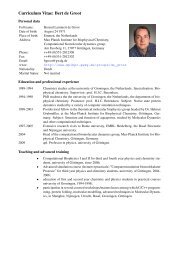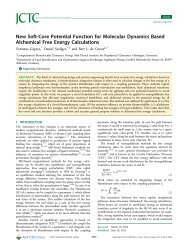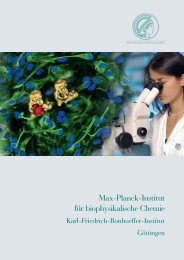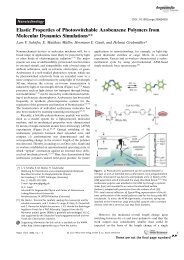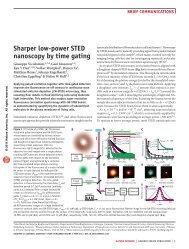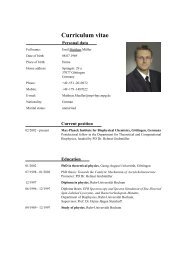Seminar for PhD students - Max-Planck-Institut für biophysikalische ...
Seminar for PhD students - Max-Planck-Institut für biophysikalische ...
Seminar for PhD students - Max-Planck-Institut für biophysikalische ...
Erfolgreiche ePaper selbst erstellen
Machen Sie aus Ihren PDF Publikationen ein blätterbares Flipbook mit unserer einzigartigen Google optimierten e-Paper Software.
Genetic screen <strong>for</strong> modifiers of muscular dystrophy in<br />
Drosophila melanogaster<br />
Muscular dystrophy (MD) is a general<br />
term that describes a group of inherited and<br />
gradually progressing myogenic disorders<br />
that are frequently associated with cardiomyopathy<br />
and brain disorders. Genetically<br />
the pattern of inheritance can be X-linked<br />
recessive as in Duchenne or Becker muscular<br />
dystrophy (DMD/BMD), autosomal<br />
dominant as in limb-girdle muscular dystrophy<br />
type 1 (LGMD type 1), or autosomal<br />
recessive as in limb-girdle muscular dystrophy<br />
type 2 (LGMD type 2) (Campbell,<br />
1995; Straub, Campbell, 1997). DMD is<br />
a severe progressive muscle-wasting<br />
disease affecting approximately 1 out of<br />
3500 males (Blake et al, 2002).<br />
One of the most important advances<br />
in understanding the molecular genetics<br />
of neuromuscular diseases has been<br />
the cloning of the gene encoding dystrophin,<br />
the protein absent in muscle of DMD<br />
patients. In the last few years the role of<br />
dystrophin in skeletal muscle has been<br />
studied, and several dystrophin-associated<br />
proteins that <strong>for</strong>m a Dystrophin-Glyco-<br />
protein Complex (DGC) have been identified.<br />
The DGC consists of dystrophin,<br />
the dystroglycans, the sarcoglycans,<br />
sarcospan, the syntrophins and dystrobrevin<br />
(Durbeej and Campbell, 2002). The<br />
DGC components are now being characterized<br />
and evidence is beginning to indicate<br />
that proteins of this complex may<br />
be responsible <strong>for</strong> other <strong>for</strong>ms of muscular<br />
dystrophy (Campbell, 1995).<br />
Un<strong>for</strong>tunately all known cases of MD<br />
belong to the category of incurable, there<strong>for</strong>e<br />
further studying of the DGC function is<br />
very important. A number of animal models<br />
have been established <strong>for</strong> DMD, but<br />
severe muscular dystrophy in the absence<br />
of dystrophin alone has only been observed<br />
in dogs (reviewed in Collins and Morgan,<br />
2003). Mice and C.elegans exhibit muscle<br />
degeneration in the absence of dystrophin<br />
when also lacking myoD (Gieseler<br />
et al., 2000; Megeney et al., 1996), a<br />
gene required <strong>for</strong> muscle regeneration.<br />
This fact makes it difficult to study the<br />
mechanisms of MD utilizing such models,<br />
Doktorandenseminar - <strong>Seminar</strong> <strong>for</strong> <strong>PhD</strong> <strong>students</strong><br />
Organizing team: W. Fischle, G. Groenhof, C. Höbartner, S. Jakobs, A. Lange<br />
Summary of the “<strong>Seminar</strong> <strong>for</strong> <strong>PhD</strong> Students“ by Mariya Kucherenko,<br />
<strong>Max</strong> <strong>Planck</strong> Research Group of Gene expression and signaling, 12.8.2009<br />
hence development of a new remarkably<br />
good model <strong>for</strong> genetic manipulations<br />
remains an open task.<br />
Drosophila melanogaster was used as<br />
a model <strong>for</strong> human diseases previously.<br />
Characterization of the fly DGC shows<br />
that the fruit fly retains all essential components<br />
of the DGC, but with substantially<br />
less diversity (Greener and Roberts, 2000).<br />
Furthermore, regions and domains known<br />
to mediate interactions between members<br />
of the complex are highly conserved between<br />
human and fly, suggesting that the<br />
overall structure of the complex is identical<br />
(Neuman et al, 2005). Recently, a<br />
model <strong>for</strong> muscular dystrophy caused by<br />
Dystrophin (Dys) and Dystroglycan (Dg)<br />
deficiency was established in Drosophila<br />
melanogaster and phenotypes similar with<br />
human neuromuscular diseases were<br />
described (Shcherbata et al, 2007). Mutations<br />
in Drosophila Dystrophin and Dystroglycan<br />
genes cause shortened lifespan and<br />
reduced mobility as a result of age dependent<br />
muscle degeneration. In addition, the<br />
(+) inretaction; (-) no interaction; (En) enhancement.<br />
Seite 20<br />
reduction of Dys and Dg leads to defects in<br />
eye development as manifested by altered<br />
photoreceptor axon path-finding.<br />
To review new components that interact<br />
with the DGC or regulate its function we<br />
used a Drosophila melanogaster model <strong>for</strong><br />
muscular dystrophy and per<strong>for</strong>med genetic<br />
interaction screens to identify dominant<br />
modifiers of Dg and Dys related mutant<br />
phenotypes. In the primary large scale<br />
screen we looked <strong>for</strong> modifications of<br />
an easily score-able phenotype such as<br />
alterations in the posterior crossvein.<br />
Using this screening strategy we have found<br />
38 modifiers that belong to different functional<br />
groups: genes involved in muscle<br />
function, neuronal/cell migration and<br />
motor function as well as cytoskeletal<br />
components and components of the TGFbeta,<br />
EGFR and Notch signaling pathways<br />
(Kucherenko et al, 2008).<br />
In order to shed light on the mechanisms<br />
of muscle degeneration caused by Dys and<br />
Dg down regulation a secondary screen<br />
in muscle tissue was per<strong>for</strong>med (Figure<br />
Table 1. Modifiers of muscle degeneration phenotype caused by reduced level of Dys and Dg.




